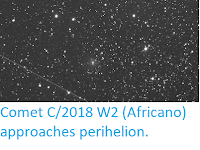Comet 114P/Wiseman-Skiff will make its closest approach to the Earth on Wednesday 4 December 2019, reaching a distance of 0.71
AU from the Earth (71%
of the distance between the Earth and the Sun, or 106 364 000 km). At
this distance the comet will be not naked eye visible, having a
magnitude of slightly over 14, requiring a reasonably good telescope to
see it, in the Constellation of Andromeda, which is better observed from
the
Northern Hemisphere, though viewing for those with the right equipment should be reasonable as the closest approach coincides with the First Quarter Moon, so that glare from the Moon should not be excessive.
Image of Comet 114P/Wiseman-Skiff taken from Ehime Prefecture, Japan, in October 1999. Position of comet is indicated by two lines. Akimasa Nakamura/Kuma Kogen Astronomical Observatory/Cometography.
Comet 114P/Wiseman-Skiff was discovered in January 1987 by Jennifer Wiseman, then an undergraduate at the Michigan Institute of Technology, while examining two photographic plates taken in December 1986 by Brian Skiff at Lowell Observatory in Flagstaff, Arizona. The designation 114P/Wiseman-Skiff implies that it was the 114th Periodic Comet (Periodic Comets are defined as comets with orbital periods of less than 200 years) discovered, and that it was discovered by Wiseman and Skiff.
The calculated orbit and current position of 114P/Wiseman-Skiff. JPL Small Body Database.
Comet 114P/Wiseman-Skiff has an orbital period of 2435 days (6.67 years) and a
highly eccentric
orbit tilted at an angle of 18.3° to the plain of the Solar System, that
brings it from 1.57 AU from the Sun at perihelion (157% of the distance
between the Earth and the Sun, and slightly outside the orbit of the planet Mars);
to 5.51 AU from the Sun at aphelion (5.51 times as far from the Sun as
the Earth or slightly outside the orbit of the planet Jupiter). As a
comet with a period of less
than 20 years with an orbit angled at less than 30° to the plane of the
Solar System, 114P/Wiseman-Skiff is considered to be a Jupiter Family Comet.
See also...
Follow Sciency Thoughts on Facebook.








